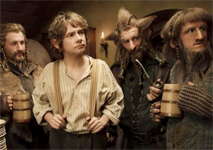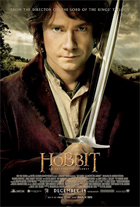The Hobbit: An Unexpected Journey
|  If The Hobbit: An Unexpected Journey, the first installment of Peter Jackson’s three-part adaptation of J.R.R. Tolkien’s 1937 novel that introduced the world to the fantastical realm of Middle-earth, suffers in comparison to his Lord of the Rings trilogy (2001–2003), it is primarily because it lacks the exhilarating newness of the previous films. The Lord of the Rings benefitted commercially and critically from the fact that it was the first (and so far best) of its kind; never before had a filmmaker attempted to mount a fantasy epic on such a scale in the digital era, and its breathtaking vistas (partially computer generated, partially shot on location in the previously unfilmed wilds of New Zealand) made movies seem new and vibrant again, as if Jackson had tapped into some new, previously unknown cinematic vein. The Hobbit is very much in that vein, although its inherent familiarity works both for it and against it. Longtime fans will embrace it as a homecoming, a return to the world that Jackson made so indelible in the previous films, but those who are seeking something new and revelatory might find themselves just a bit disappointed. If The Hobbit: An Unexpected Journey, the first installment of Peter Jackson’s three-part adaptation of J.R.R. Tolkien’s 1937 novel that introduced the world to the fantastical realm of Middle-earth, suffers in comparison to his Lord of the Rings trilogy (2001–2003), it is primarily because it lacks the exhilarating newness of the previous films. The Lord of the Rings benefitted commercially and critically from the fact that it was the first (and so far best) of its kind; never before had a filmmaker attempted to mount a fantasy epic on such a scale in the digital era, and its breathtaking vistas (partially computer generated, partially shot on location in the previously unfilmed wilds of New Zealand) made movies seem new and vibrant again, as if Jackson had tapped into some new, previously unknown cinematic vein. The Hobbit is very much in that vein, although its inherent familiarity works both for it and against it. Longtime fans will embrace it as a homecoming, a return to the world that Jackson made so indelible in the previous films, but those who are seeking something new and revelatory might find themselves just a bit disappointed.The events in The Hobbit take place 60 years before the events in The Lord of the Rings, although Jackson and his co-screenwriters Fran Walsh, Philippa Boyens, and Guillermo del Toro (the latter of whom was attached to direct for three years and finally dropped out to pursue other projects) choose to start the film at the same point where The Fellowship of the Ring (2001) began, making its opening sequences feel like outtakes from 10 years ago. Nevertheless, it is a comforting starting point that also allows for the brief return of familiar faces, particularly Elijah Wood as Frodo, who would go on to become the hero of The Lord of the Rings, and Ian Holm as the older hobbit Bilbo Baggins, whose extensive adventures are the subject of The Hobbit. Like The Fellowship of the Ring, the action in The Hobbit begins in the Shire with the arrival of the wizard Gandalf (Ian McKellen) to Bilbo’s home. Gandalf organizing a mission by 13 dwarves led by Thorin Oakenshield (Richard Armitage) to recover the treasure from their ancestral home deep inside Misty Mountain. A fiery prologue explains how the dwarf race mined gold and jewels inside the mountain and built up a huge treasure before being run out by a giant dragon named Smaug, who took up residence inside the mountain and has been there ever since. Thorin and the other dwarves, driven by ancestral pride, want to reclaim both their home and the treasure stored within, and for some reason that is beyond them Gandalf thinks that Bilbo, an entirely contented and unadventurous hobbit who is more interested in maintaining his mother’s china than risking life and limb, would be an important addition to the group. After much protesting Bilbo does end up joining them, and An Unexpected Journey chronicles the first part of their travels to the Misty Mountain, to which they believe they can gain entrance through a secret, long-hidden door. Their journey plays out like a serialized adventure (which is largely how Tolkien wrote the book, originally intended for younger readers), divided as it is into a number of cliff-hanging mini-adventures that involve the group being captured and needing to escape imminent demise at the hands of a trio of mountain trolls, a hoard of goblins, and a rampaging group of Orcs. Along the way they also stop by Rivendell, the picturesque home of the elves, whose king Elrond (Hugo Weaving) is one of the only people able to decipher the hidden runes on the dwarves’ map. Other familiar characters, including the elf Galadriel (Cate Blanchett) and the wizard Saurman (Christopher Lee), also show up, the latter of whom appears in the film only because Jackson has expanded significantly on Tolkien’s novel by adding in scenes and subplots from the author’s other works (which is why a book of only a few hundred pages has been turned in a trilogy whose length rivals one adapted from three books totaling more than a thousand pages). For what it’s worth, the first installment of The Hobbit hits all the right notes and delivers what will be expected of it: impressive scenery, memorably gnarled creatures, comically humanizing bits like Gandalf bumping his head on Bilbo’s chandelier, vast swooping camera movements that follow the action from vertiginous heights, and plenty of musical crescendos and haunting choruses to drive home the weight and gravity of it all (Jackson also tries to advance cinematic technology again, this time by using both 3D and shooting at 48 fps—twice the normal frame rate—although only a precious handful of theaters are equipped to project it properly). Granted, The Hobbit: An Unexpected Journey is a decidedly lighter film than the three Lord of the Rings entries, partially because the stakes feel much lower. After all, Frodo was on a quest to save the entirety of Middle-earth from complete destruction at the hands of an evil monstrosity, while The Hobbit is about a group of dwarves who want their gold back. It just doesn’t carry the same narrative heft, but Jackson pours it on anyway, carefully escalating the tone from the comical slapstick of the opening quarter (which features an extended sequence in which the dwarves arrive one-by-one and proceed to take over Bilbo’s house with a raucous dinner party) to the dark, violent confrontations that bring it to its perilious climax. And, of course, there is Gollum (Andy Serkis), the pathetic, hateful creature who Bilbo stumbles upon underground and essentially tricks out of his “Precious”—the fabled “One Ring” that will become the center of the action in The Lord of the Rings. Gollum, an entirely digital creation based on actor Andry Serkis’s bodily and facial motion capture, looks better than ever, and Serkis again imbues him with a complex, contradictory humanity that is equal parts sad and loathsome, victim and murderer. First-time readers of The Hobbit are led to believe that his “Precious” is little more than a magic ring that can make the wearer invisible, but we know better, and that foreknowledge of things to come makes the best moments in The Hobbit—which is, truth by told, probably half an hour longer than it needs to be—crackle with energy, fairly or not. Copyright ©2012 James Kendrick Thoughts? E-mail James Kendrick All images copyright © Warner Bros / New Line Cinema / MGM |
Overall Rating: 

 (2.5)
(2.5)


